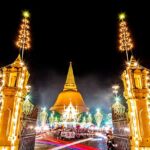
In bustling Bangkok, the Giant Swing symbolizes the city’s rich cultural heritage, known as ‘Sao Ching Cha.’ It’s more than an architectural marvel; it’s a testament to Thailand’s spiritual and historical legacy. In this article, we’ll explore the history, significance, and allure of the Giant Swing.
The Swing’s history dates to the 19th century, built near the Devasathan Shrine by King Rama I. It served as a prominent religious and ceremonial site, focusing on the annual ‘Swing Ceremony’ during the Brahmin festival of Triyampavai-Tripavai.

The Swing Ceremony, in turn, celebrated the rice harvest and the new year. Young Brahmin priests would swing from the Giant Swing, aiming to grab a bag of gold coins with their teeth, symbolizing prosperity and blessings for the year.
The Giant Swing holds a deeper spiritual significance beyond its historical festivities. Moreover, it symbolizes Hinduism’s centrality in Thai culture and the unity of religion and the monarchy. Adjacent to the Devasathan Shrine, it showcases the interconnectedness of Thai spirituality and traditions.
The Giant Swing is a striking architectural masterpiece. Additionally, its towering teakwood pillars, adorned with intricate carvings, soar into the Bangkok sky. The structure exudes a sense of grandeur, invoking a profound respect for the craftsmanship of the past. Furthermore, the surrounding area, with its manicured gardens and ceremonial pavilions, adds to the serene ambiance.
While the Swing Ceremony was a revered tradition for centuries, safety concerns led to its discontinuation. People considered the high-flying ceremony hazardous to participants. In 1935, they relocated the structure to its current position in front of Wat Suthat Thepwararam.Although the ceremony no longer takes place, the Giant Swing remains a cherished historical and cultural symbol.

Centrally located in Bangkok, near the Grand Palace and Wat Pho, it lets visitors explore intricate details and appreciate its spiritual and historical significance. The Giant Swing Bangkok is a living testament to Thailand’s cultural and spiritual heritage.
Additionally, let’s continue to Lumphini Park , which is in the same area of the province.












One thought on “Giant Swing Bangkok: A Symbol of Tradition and Spirituality”
Comments are closed.